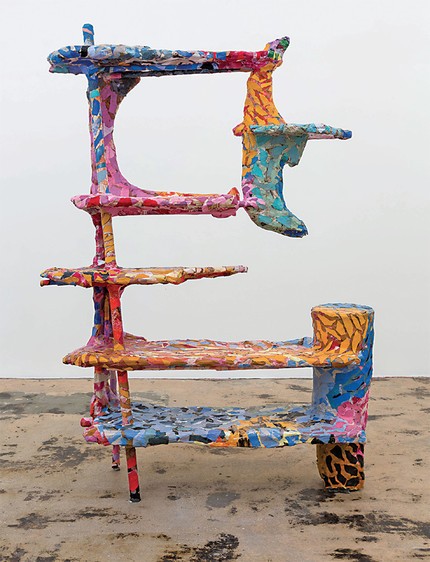If the function of designer furniture is to abandon the utilitarian demands of everyday life in favor of sleek aesthetics, Brooklyn-based designer and artist Katie Stout’s “naive pop” objects—twenty of which were recently on view at Nina Johnson in Miami as part of the exhibition “Narcissus”—are not always cooperative. Following in the legacy of artists such as Judy Chicago, Nicola L., Miriam Schapiro, and Alina Szapocznikow, Stout’s works subvert the space of the domestic, renouncing stale notions of beauty that take the female form as a given. Buxom caricatures stand in as furniture, their eroticisms flashing like epithets to their own mislabeling. These static pantomimes thumb their noses at tradition.
In Narcissus Chandelier, 2017, ceramic bodies are connected by gray ligaments to fashion a lampshade. Extruding from the bulb at the chandelier’s center, the figures—who bare knobby breasts and prominent genitalia and are variously sculpted from pink, periwinkle, salmon, and pewter clay—evoke a Maximalist style. Stout pares down the body to a homely set of Play-Doh-like forms, a DIY tactic that can be interpreted as a revolt against highbrow artifice. Cuteness here begs us to assume a simpler relation to commodities, one in which we afford them leeway as a formal category without direct valuation. These objects could be taken as pseudoprimitivist sculptures, but they are in fact the result of Stout’s savvy deployment of lessons borrowed from contemporary art discourse—although she puts them in service of promoting a new kind of hybrid production, neither totally rarefied artwork nor high-end furniture.
This sly figurative play offers a feminized index of individual fantasy (resonating with the gendered reception she was subjected to when she participated in the television show Ellen’s Design Challenge in 2015 and ultimately won the competition). The works lend fluency to abstraction, even as they make some compromises toward usability. For Stout, who takes the trope of functionality in furniture as an easy target, scanty articulation is the cleanest way to draw a line to the grotesque. Take Shelfish, 2017, which gives lip service to use-value in borrowing the visual cues of a shelf—stacked surface areas—only to further the artist’s project of amoeboid abstraction. Two thin, uniform cylindrical beams propping up shelves quote the parsimony of modernist construction, while the sculpture’s performative proportions and rainbow papier-mâché exterior undermine the characteristic instrumental rationality of the movement. (The support also serves to keep the work structurally sound in a gesture that feels more voluntary than utilitarian.) Much in the way that auto-complete technology shapes the direction of a query, a design makes self-segregating predictions that affect, in real time, the possibilities of its interface. Foregrounding the work as a skeuomorph within the vernacular of furniture opens up and undercuts its prescriptive mandate, along the way stumbling through a freewheeling world that oscillates between figuration and ornamentation.
Staring at the uncanny scene unfolding in the gallery, one got the sense that each unique sculpture was prepared to meet the flesh of its taker. Two of the five lamps on display—One Is Silver and And the Other Is Gold, both 2017, a pair of erect women with metallic vulvas and nipples—appeared to smirk welcomingly at viewers. A viewer could toggle a lamp “on” and consent to the performative gesture of the venereal imposition happening here. Elsewhere, one’s own image was reflected in Narcissus Mirror, 2017, which is flanked by two wonky ladies wantonly holding a central glass pane aloft with their rear ends. Roughly the shape of an ellipse, the mirror was carefully cut with a wavy outline, exaggerating its irreproducibility. The precision cuts read more as emotional incisions than material interventions, intending to create kinship between users living in a culture of heightened self-representation. That’s the thing: A piece of furniture, when viewed in isolation, is an amalgam of data sets, a corollary to the greater degree of consciousness designers have in targeting pockets of unfulfilled desire, an opportunity to transcribe unconscious cultural data differently and with more brevity. Such is the ethos of “Narcissus.”
